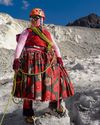
There was something wrong with the chimpanzees. For weeks, a community of 205 animals in Uganda's Kibale national park had been coughing, sneezing and looking miserable. But no one could say for sure what ailed them, even as the animals began to die.
Necropsies can help to identify a cause of death, but normally the bodies of chimps are found long after decomposition has set in. So when Tony Goldberg, a US wildlife epidemiologist visiting Kibale, got word that an adult female named Stella had been found dead, he drove straight to the park.
As the necropsy progressed, Goldberg began to see signs of a familiar disease: fluid buildup in the chest cavity and around her heart; lung tissue that was dark red, consolidated and marked with lesions. It looked like the chimp had died of severe pneumonia.
Months later, molecular testing revealed it was human metapneumovirus (HMPV), one of a collection of viruses that presents in humans as a common cold but is "a well-known killer" in our closest primate relatives, said Goldberg, a researcher at the University of Wisconsin-Madison.
More than 12% of the community that Stella belonged to died in the outbreak. Others were lost as a result of being orphaned.
This phenomenon of animals catching diseases from humans, called reverse zoonoses, affects species around the world from mussels contaminated with hepatitis A virus to tuberculosis transmitted to Asian elephants. But because of their evolutionary closeness to humans, great apes tend to be most vulnerable.
For some great ape populations that live in protected areas, reverse zoonoses are a bigger threat than habitat loss or poaching. In a group at Kibale, for example, respiratory pathogens such as human rhinovirus Cand HMPV have been the leading chimp killers for more than 35 years, accounting for 59% of deaths from a known cause.
This story is from the May 10, 2024 edition of The Guardian Weekly.
Start your 7-day Magzter GOLD free trial to access thousands of curated premium stories, and 9,000+ magazines and newspapers.
Already a subscriber ? Sign In
This story is from the May 10, 2024 edition of The Guardian Weekly.
Start your 7-day Magzter GOLD free trial to access thousands of curated premium stories, and 9,000+ magazines and newspapers.
Already a subscriber? Sign In

The Saudi football World Cup is an act of violence and disdain
Well, that's that then. In the event there were only two notes of jeopardy around Fifa's extraordinary virtual congress last week to announce the winning mono-bids, the vote without a vote, for the right to host the 2030 and 2034 football World Cups.

AI has made the move into video and it's worryingly plausible
I recently had the opportunity to see a demo of Sora, OpenAI's video generation tool, which was released in the US last Monday, and it was so impressive it made me worried for the future.

With tyrant Assad ousted, Syrians deserve support and hope
Last week, time collapsed. Bashar al-Assad's fall recalled scenes across the region from the start of the Arab spring almost 14 years ago. Suddenly history felt vivid, its memories sharpened. In fact it no longer felt like history.

TV
The Guardian Weekly team reveals our small-screen picks of the year, from the underground vaults of post-apocalyptic Fallout to the mile-high escapism of Rivals

Albums
Murky love stories, nostalgic pop and an in-your-face masterpiece captured our critics' ears in 2024

Film
Visual language, sound, light and rhythm are to the fore in the best movies of the year

Hidden delights Our 24 travel finds of 2024
Guardian travel writers share their discoveries of the year, from Læsø to Lazio

'It's really a disaster' The fight to save lives as gang war consumes capital
Dr James Gana stepped out on to the balcony of his hospital overlooking a city under siege. \"There's a sensation of 'What's next?'. Desperation is definitely present,\" the Médecins Sans Frontières (MSF) medic said, as he stared down at one of scores of camps for displaced Haitians in their country's violence-plagued capital.

Trailblazers The inspiring people we met around the world this year
From an exuberant mountaineer to a woman defiantly facing the guns of war, here are some of the brave individuals who gave us hope in a tumultuous 2024

Votes of confidence
From India to Venezuela and Senegal to the US, more people voted this year than ever before, with over 80 elections across the world. With rising authoritarianism and citizen-led resistance revealing its vulnerabilities and resilience in the face of unprecedented challenges, has democracy reached its breaking or turning point?